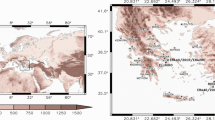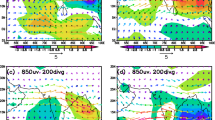Abstract
The aim of this work is to investigate the recent past and future patterns of the Etesian winds, one of the most persistent localized wind systems in the world, which dominates the wind regime during warm period over the Aegean Sea and eastern Mediterranean. An objective classification method, the Two Step Cluster Analysis (TSCA), is applied on daily data from regional climate model simulations carried out with RegCM3 for the recent past (1961–1990) and future periods (2021–2050 and 2071–2100) constrained at lateral boundaries either by ERA-40 reanalysis fields or the global circulation model (GCM) ECHAM5. Three distinct Etesian patterns are identified by TSCA with the location and strength of the anticyclonic action center dominating the differences among the patterns. In case of the first Etesian pattern there is a ridge located over western and central Europe while for the other two Etesian patterns the location of the ridge moves eastward indicating a strong anticyclonic center over the Balkans. The horizontal and vertical spatial structure of geopotential height and the vertical velocity indicates that in all three Etesian patterns the anticyclonic action center over central Europe or Balkan Peninsula cannot be considered as an extension of the Azores high. The future projections for the late 21st century under SRES A1B scenario indicate a strengthening of the Etesian winds associated with the strengthening of the anticyclonic action center, and the deepening of Asian thermal Low over eastern Mediterranean. Furthermore the future projections indicate a weakening of the subsidence over eastern Mediterranean which is rather controlled by the deepening of the south Asian thermal Low in line with the projected in future weakening of South Asian monsoon and Hadley cell circulations.











Similar content being viewed by others
References
Bartzokas A, Metaxas DA (1995) Factor analysis of some climatological elements in Athens, 1931–1992: covariability and climatic change. Theor Appl Climatol 52:195–205
Borhan Y (1998) Mesoscale interactions on wind energy potential in the northern Aegean region: a case study. Renew Sustain Energy Rev 2:353–360
Brody LR, Nestor MJR (1985) Regional forecasts for the Mediterranean basin. Technical report, no. 80–110. Naval Environmental Prediction Research Facility, Monterey
Burlando M (2009) The synoptic-scale surface wind climate regimes of the Mediterranean Sea according to the cluster analysis of ERA-40 wind fields. Theor Appl Climatol 96:69–83
Charney JG (1975) Dynamics of deserts and drought in the Sahel. Q J R Meteorol Soc 101:193–202
Chronis T, Raitsos DE, Kassis D, Sarantopoulos A (2011) The summer north Atlantic oscillation influence on the eastern Mediterranean. J Clim 24(21):5584–5596. doi:10.1175/2011JCLI3839.1
Eshel G (2002) Mediterranean climates. Israel J Earth Sci 51:157–168
Gao X, Shi Y, Song R, Giorgi F, Wang Y, Zhang D (2008) Reduction of future monsoon precipitation over China: comparison between a high resolution RCM simulation and the driving GCM. Meteorol Atmos Phys 100:73–86. doi:10.1007/s00703-008-0296-5
Giorgi F, Marinucci M, Bates G (1993a) Development of a second generation regional climate model (RegCM2), Part I: boundary layer and radiative transfer processes. Mon Weather Rev 121:2794–2813
Giorgi F, Marinucci M, Bates G, DeCanio G (1993b) Development of a second generation regional climate model (RegCM2), Part II: convective processes and assimilation of lateral boundary conditions. Mon Weather Rev 121:2814–2832
Held IM, Soden BJ (2006) Robust responses of the hydrological cycle to global warming. J Clim 19:5686–5699
Kallos G, Kotroni V, Lagouvardos K, Papadopoulos A (1998) On the long range transport of air pollutants from Europe to Africa. Geophys Res Lett 25:619–622. doi:10.1029/97GL03317
Karapiperis L (1951) On the periodicity of Etesian in Athens. Weather 6:378–379
Kaufmann P, Whiteman CD (1999) Cluster-analysis classification of wintertime wind pattern in the Grand Canyon Region. J Appl Meteorol 38:1131–1147
Kotroni V, Lagouvardos K, Lalas D (2001) The effect of the island of Crete on the Etesian winds over the Aegean Sea. Q J R Meteorol Soc 127:1917–1937. doi:10.1002/qj.49712757604
Lionello P, Sanna A (2005) Mediterranean wave climate variability and its links with NAO and Indian Monsoon. Clim Dyn 25:611–623. doi:10.1007/s00382-005-0025-4
Lu J, Vecchi GA, Reichler T (2007) Expansion of the Hadley cell under global warming. Geophys Res Lett 34:L06805. doi:10.1029/2006GL028443
Maheras P (1980) Le problème des étésiens. Revue Géographique Méditerranéen 40:55–66
Maheras P (1983) Le climat de la mer Egée et de ses marges continentales. Thèse de Doctorat d’Etat. Atelier de reproduction de thèses de Lille III, p 784
Maheras P, Tolika K, Anagnostopoulou C, Kolyva-Machaira F (2012) Types de circulation associés au flux des Etésiens dans la mer Egée. 25ème Colloque de l’Association Internationale de Climatologie (AIC). Grenoble 2012:494–498
Makrogiannis TJ, Dikaiakos JC (1990) Large scale patterns of atmospheric circulation anomalies associated to long spells of etesian wind-days over Greece. In: Brazdil R (ed) Climatic change in the historical and the instrumental periods. Mararyk University, Brno, pp 307–309
May W (2004) Potential future changes in the Indian summer monsoon due to greenhouse warming: analysis of mechanisms in a global time-slice experiment. Clim Dyn 22:389–414. doi:10.1007/s00382-003-0389-2
Metaxas DA (1977) The interannual variability of the etesian frequency as a response of atmospheric circulationanomalies. Bull Hell Meteor Soc 2(5):30–40
Metaxas DA, Bartzokas A (1994) Pressure covariability over the Atlantic, Europe and N. Africa. application: centers of action for temperature, winter precipitation and summer winds in Athens, Greece. Theor Appl Climatol 49:9–18
Mitas CM, Clement A (2005) Has the Hadley cell been strengthening in recent decades? Geophys Res Lett 32:L03809. doi:10.1029/2004GL021765
Meteorological Office (1962) Weather in Mediterranean. General meteorology, vol I, 2nd edn. H.M.S.O, London
Norušis MJ, Inc. SPSS (2011) IBM SPSS statistics 19 guide to data analysis. Statistical procedures companion. ISBN-10:0-321-74842-5 ISBN-13:978-0-321-74842-3672
Pal JS, Giorgi F, Bi X, Elguindi N, Solomon F, Gao X, Rauscher SA, Francisco R, Zakey A, Winter J, Ashfaq M, Syed FS, Bell JL, Diffenbaugh NS, Karmacharya J, Konare A, da Martinez D, Rocha RP, Sloan LC, Steiner AL (2007) Regional climate modelling for the developing world: the ICTP RegCM3 and RegCNET. B Am Meteorol Soc 88:1395–1409
Poulos S, Drakopoulos P, Collins M (1997) Seasonal variability in sea surface oceanographic conditions inthe Aegean Sea (eastern Mediterranean): an overview. J Mar Syst 13:225–244
Poupkou A, Zanis P, Nastos P, Papanastasiou D, Melas D, Tourpali K, Zerefos C (2011) Present climate trend analysis of the Etesian winds in the Aegean Sea. Theor Appl Climatol 106:459–472. doi:10.1007/s00704-011-0443-7
Prezerakos GN (1984) Does the extension of the Azores’ anticyclone towards the balkans really exist? Arch Meteorol Geophys Bioclimatol A33:217–227
Reddaway JM, Bigg GR (1996) Climatic change over the Mediterranean and links to the more general atmospheric circulation. Int J Climatol 16:651–661
Repapis C, Zerefos C, Tritakis B (1978) On the Etesians over the Aegean. Proc Acad Athens 52:572–606
Rodwell MJ, Hoskins B (1996) Monsoons and the dynamic of deserts. Q J R Meteorol Soc 122:1385–1404
Rodwell MJ, Hoskins BJ (2001) Subtropical anticyclones and summer monsoons. J Clim 14:3192–3211
Roeckner E, Bäum G, Bonaventura L, Brokopf R, Esch M, Giorgetta M, Hagemann S, Kirchner I, Kornblueh L, Manzini E, Rhodin A, Schlese U, Schulzweida U, Tompkins A (2003) The atmospheric general circulation model ECHAM5. Part I: model description. Max Planck Institute for Meteorology Rep. 349, p 127
Tolika K, Zanis P, Anagnostopoulou C (2012) Regional climate change scenariosfor Greece: future temperature and precipitation projections from ENSEMBLEs of RCMs. Global Nest J 14(4):407–421
Tyrlis E, Lelieveld J (2013) Climatology and dynamics of the summer Etesian winds over the eastern Mediterranean. J Atmos Sci (in press). doi:10.1175/JAS-D-13-035.1
Tyrlis E, Lelieveld J, Steil B (2012) The summer circulation over the eastern Mediterranean and the Middle East: influence of the South Asian monsoon. Clim Dyn 40(5):1103–1123. doi:10.1007/s00382-012-1528-4
Ueda H, Iwai A, Kuwako K, Hori ME (2006) Impact of anthropogenic forcing on the Asian summer monsoon as simulated by eight GCMs. Geophys Res Lett 33:L06703. doi:10.1029/2005GL025336
Uppala SM, Kallberg PW, Simmons AJ, Andrae U, da Costa Bechtold V, Fiorino M, Gibson JK, Haseler J, Hernandez A, Kelly GA, Li X, Onogi K, Saarinen S, Sokka N, Allan RP, Andersson E, Arpe K, Balmaseda MA, Beljaars ACM, van de Berg L, Bidlot J, Bormann N, Caires S, Chevallier F, Dethof A, Dragosavac M, Fisher M, Fuentes M, Hagemann S, Holm E, Hoskins BJ, Isaksen L, Janssen PAEM, Jenne R, McNally AP, Mahfouf JF, Morcrette JJ, Rayner NA, Saunders RW, Simon P, Sterl A, Trenberth KE, Untch A, Vasiljevic D, Viterbo P, Woollen J (2005) TheERA-40 re-analysis. Q J Roy Meteor Soc 131:2961–3012
Vecchi GA, Soden BJ (2007) Global warming and the weakening of the tropical circulation. J Clim 20:4316–4340. doi:10.1175/JCLI4258.1
Wilks DS (1995) Statistical methods in the atmospheric sciences. Academic Press, San Diego. ISBN 0-12-751965-3
Zecchetto S, de Biasio F (2007) Sea surface winds over the Mediterranean basin from satellite data (2000–04): meso- and local-scale features on annual and seasonal time scales. J Appl Meteorol Climatol 46:814–827
Ziv B, Saaroni H, Alpert P (2004) The factors governing the summer regime of the eastern Mediterranean. Int J Climatol 24:1859–1871. doi:10.1002/joc.1113
Author information
Authors and Affiliations
Corresponding author
Rights and permissions
About this article
Cite this article
Anagnostopoulou, C., Zanis, P., Katragkou, E. et al. Recent past and future patterns of the Etesian winds based on regional scale climate model simulations. Clim Dyn 42, 1819–1836 (2014). https://doi.org/10.1007/s00382-013-1936-0
Received:
Accepted:
Published:
Issue Date:
DOI: https://doi.org/10.1007/s00382-013-1936-0




